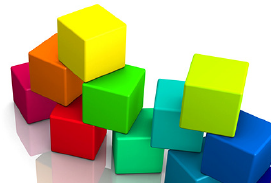This problem solving activity has a number (addition, multiplication, and division) focus.
Kelsey loves to count.

Kelsey began to count the cubes.
She told Ms Martin the following facts about the cubes:
When I count the cubes by two I have one left over.
When I count the cubes by three I have one left over.
When I count by five I have none left over.
From this information can Ms Martin work out how many cubes Kelsey has?
- Skip count in 2s, 3s, and 5s.
- Devise and use problem solving strategies (make an organised list).
This problem involves skip counting.
This kind of problem is very useful for finding number patterns. As the students go through the problem they should begin to see some patterns that will tell them more about the solution to Kelsey’s problem.
The other interesting thing about this problem is that there is redundant information. Not all of the information is helpful because it is already contained as part of other information. If students can see this it will cut down the number of calculations that they will have to make.
- Cubes to introduce the problem (these could be presented in digital form)
- Copymaster of the problem (English)
- Copymaster of the problem (Maori)
- Hundreds board (or digital representation)
The Problem
Kelsey loves to count. One day Ms Martin put a pile of cubes on Kelsey’s desk. Kelsey began to count the cubes. She told Ms Martin the following facts about the cubes:
When I count the cubes by two I have one left over.
When I count the cubes by three I have one left over.
When I count by five I have none left over.
From this information can Ms Martin work out how many cubes Kelsey has?
Teaching Sequence
- Start counting backwards in 2s from 30. Ask the students to join in when they have worked out the pattern.
30 ..28..26..24..22..
Try other skip counting patterns for the students to follow.
1..3..5..7..9
Let the students invent their own counting patterns. - Introduce the problem using a pile of cubes. Check that the students understand the problem before getting them to solve it with a partner. Tell them that they will need to use counting patterns to help them solve the problem.
- As the students solve the problem encourage them to use materials, words, acting out, and/or diagrams to explain their thinking.
- Ask questions that allow you to determine if they can understand the ideas of counting by 2s and having a remainder. Do they realise that if one cube was left after counting by 4s then the number of cubes must be in the sequence 1..5..9..13..?
- Make sure that the students are recording their solution so that they can justify their thinking to others.
- Share records.
Solution
The lowest number of cubes that Kelsey could have is 25.
The students could show this on a number line or in an organised list. The lists below show that number 25 is the first number to appear in each of the number sequences described by Kelsey.
| 2s 1 3 5 7 9 11 13 15 17 19 21 23 25 | 3s 1 4 7 10 13 16 19 22 25 | 5s 5 10 15 20 25 |